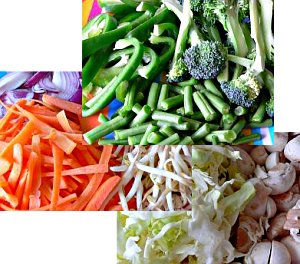Monday, December 3, 2007
Chinese Egg Noddles
==========
1. 2 packets of noodles (1 packet = 250 gm)
2. 4 eggs
3. Salt
4. Oil
5. 2 packet of Spring Onion (1 packet = 2 spring onions)
6. 250 gm French Beans
7. Water
8. Tomato Sauce
9. Soya Sauce
10. Chilli Sauce (made of green chillies) - This is optional
11. One large non-stick oval shaped pan with wooden ladle
Recipe:
=====
1. Fill the non-stick pan with 3/4 of its size with water and put the noodles from 1 packet. Break the noodles into 2 to make space for all to sink in the water
2. Allow the mixture to boil. Stir occassionally. Boil for say 5 minutes till the noodles are soft
3. Pour cold water in the pan and strain the noodles. Put the noodles in the strainer
4. Beat 2 eggs - 2 for each packet of noodles and add quarter teaspoon of salt and batter the mixture.
5. Wash the pan properly and put oil in it till the base of the pan is covered with oil
6. Heat the pan and allow the heat the oil
7. Add the battered egg to the heated oil and scramble the mixture with the ladle for say 2-3 minutes.
8. Remove the scrambled eggs from the pan to a separate dish and cover it with a lid to keep it warm
9. Wash the pan and put oil in it till the base of the pan is covered with oil
10. Heat the pan and allow the heat the oil
11. Till time the oil is heating, chop the beans and green portion of spring onion to 1 inch size
12. Chop the bulb portion of the spring onion into fine circles
13. Once the oil is heated, put the chopped circles of spring onion till it becomes light brown
14. Add the rest of spring onions and beans to the mixture in the pan and stir occassionally for say 5 minutes.
15. Add the strained noodles to the mixture and stir occassionally till the noodles start sticking to the pan
16. Remove the contents of the pan to a separate dish
17. Serve the noodles with the scrambled eggs and tomato, soya and chilli sauce. Repeat the process for the second packet of the noodles.
Wednesday, November 28, 2007
The Yummy Chaat Special
Swaroop's paneer bread pakora was instant hit with hungry tummys prepared just after Pat's dish. This was followed by Amit's Chicken Lollypop's for non-vegetarian's delight and on ther hand the vegetarians were awe struck by Megha's interesting 'Vegatable Hotdog'. After these two dishes, the food lovers of the club still had the apetite for Ritu's crispy 'Dal Tikki' which were presented exotically along with green coriander chutney.
This meeting had a chinese guest in Lydia who was zapped by the concept of the club and its tasty proceedings thereafter.
Monday, October 29, 2007
Chicken Lollipop
Ingredients:
==================
16 Chicken wings
1 Cup breadcrumbs
1 tbsp Corn flour
1/2 tsp Salt
2 Eggs
1 tbsp White pepper
Oil for deep frying
A pinch of ajino motto (optional)
Cooking Instructions:
======================
Take a bowl and beat egg in it.
Add corn flour, breadcrumbs, ajno motto, white pepper and salt and make a fine batter.
Now mix chicken wings with it.
Heat oil in a deep bottomed pan and deep fry chicken wings one at a time until dark brown.
Chicken Lollipop is ready to serve.
Sunday, September 23, 2007
Summer Specials: Paratha special, West India Special and East India Special
'Paratha special' saw parathas coming out of result of both experiments as well as the traditional ones. The experimented ones were the onion paratha, mixed veg paratha while the traditional ones were paneer paratha and poren poulli. Each of the members demonstrated cooking one paratha each while the rest were already prepared.
The next to follow was 'West India Special' where the dishes came out from various parts of West India viz. Rajasthan , Gujarat and Maharashtra. This meeting saw Mr. Sanket Pattekar preparing an exotic maharashtrian non-veg dish known as Chicken Sukha dry. However, the proceeding started with Amit who prepared made to order Bhaigan Bhaaja which was an instaneous hit with empty stomachs. While Ashwini made preparations for ghee soaked marwadi suji ka halwa; Ritu started with preparing Kadi. The thick kadi had pakodis of peas. This was an experiment which paid off in the end. Amit, being Bengali though brought up in Gujarat, prepared his mixed 'Shaak' with Sanket's dish. The members enjoyed the dishes with rice. The last nail was the tasty sooji ka halwa which made us experience the ruchness of Marwad.
The end of summer saw 'East India Special' to compete the success of the previous meet. This meeting had Mr. Swaroop with his wife Sarbani as guest chefs who prepared an out of the world, 'Bengali Mutton Curry'. This spicy dish would definitely give chettinaad chicken run out of its money. Pat, played a real host and prepared the other dishes. Starter was Baigan Pakora, vegetarian was Gobhi and then the sweetish cutish dish 'Doi Mishti'. The main course was eaten with rice and members really had a tummy full day.
Chicken Sookha Dry By Sanket Pattekar
500gm. Chicken.
1 tsp. chili powder.
1 tsp. garam masala.
1 tsp. dhania powder.
1/2 tsp.jeera powder.
1/2 tsp. poppy seeds.
1/2 tsp. nutmeg powder.
2 pinch of turmeric powder
Pinch of hing.
Salt to taste
5 flakes of garlic.
1/2 inch ginger.
4 green chilies.
Small amt. of coriander.
2 small onions.
1 tomato
1 tbsp. ghee.
3-4 clove
1-2 pieces of cinnamon
2 Black cardamom
Pinch of shahi jeera
1/2 tbsp lemon juice.
1 tsp. butter
Coriander for garnishing
Preparation:
Cut chicken into small, even pieces and put it in a bowl. Add chili powder, garam masala, dhania powder, .jeera powder, poppy seeds, nutmeg powder, turmeric powder,salt and hing and mix well.
Mix garlic, ginger, chilies and coriander to a fine paste, and add this to chicken. Keep this chicken marinated for at least 2 hours.
Take a heavy bottom pan, add ghee, clove, cinnamon, cardamom and allow it to sputter. To this add shahi jeera and onions, and sauté the same till onion become golden brown. To this add tomatoes, and sauté for 5 mins.
Add the marinated chicken and sauté it on high flame. Reduce the flame ad keep mixing till the chicken is dry.
Add some water and allow the chicken to cook. After the chicken is cooked sauté on high flame, till the chicken is completely dry.
Garnish this with lemon, butter and coriander
Tips:
Poppy seeds, Nutmeg powder, and Ghee are must for this recipe
This recipe is slightly spicy. Reduce the quantity of Garam masala, to ½ tsp, if desired
This recipe is very dry. If you want to have gravy, increase the onions to 3 in number and tomatoes to 2
This recipe can be had as starter or with roti.
Tuesday, August 14, 2007
Shaak-Bhaaji Mixed
3-4 small Carrots
100 gms of Green Beans
2-3 medium sized Potatoes
1 medium sized Tomatoes
1 medium sized Cauliflower
Oil
Salt to taste
1 spoon of Garam Masala (containing Cumin, Coriander, Red chilli)
1 spoon Turmeric powder (heaped)
1.5 medium sized sliced Onions
Medium sized Kadhai with cover
Wooden ladle
water
How to make Shaak-Bhaji Mixed:
1. Wash all the vegetables
2. Chop the carrots into small circular pieces after peeling off the outer skin
3. Chop the beans into an inch sized pieces
4. Chop the cauliflower into medium size pieces after removing the hard pieces from the bottom
5. Chop the tomatoes into circular pieces and remove the seeds from inside
6. Peel the skin of the potatoes and then make 4 slizes of each
7. Slice and dice the onions into very small pieces
8. Put the kadhai on medium heat and pour oil upto quarter of the kadhai's height
9. Fry the potatoes first till golden brown
10. Put the onions and fry till brown
11. Put all the vegetables and stir fry
12. Along with the vegetables, add the garam masala, turmeric powder and salt to taste and keep on stirring for 5 minutes
13. Add water such that all the vegetable pieces are soaked more than 50% in water
14. Put the cover on the kadhai and allow the contents to cook for about 15-20 minutes till all the water is absorbed
15. Between 5 min interval, open the cover and check if the vegetable pieces are boiled or if the salt is per taste. Add more sal, turmeric and garam masala if needed
16. After cooking, remove the kadhai from burner and allow the mixture to cool. Do not serve right after removing from burner
BEGUN BHAJA RECIPE
oil to fry
1 tsp turmeric powder
salt to taste
2 big size brinjals
How to make begun bhaja :
Wash and cut the brinjals into half inch round slices.
Apply salt and turmeric powder.
Heat up the oil in a pot to smoking point.
Take off heat, cool slightly and then reheat.
Fry the brinjal pieces till crunchy and brown.
Serve hot.
Sunday, June 3, 2007
Going West (of Amsterdam)
Kotmir wadi by Ashwini
Poha by Prakash
Vegetarian Korma by guest chef - Achut Shanbagh
Toran (mallu dish) by Roja
and dessert 'Sondesh'( of two types) by Pathikrit
Ashwini initiated the proceedings with explainations about Kotmir wadi along with its ingredients. Pat, in the mean time, started preparing for Sondesh(es) as well. He gave a tasty surpise when he said that he's going to prepare infact two type of Sondesh: a normal one and a chocolate one. Prakash had to wait for his Poha while Kothimbir wadis were getting fried. Hungry people had their mouth ful with delicious Kothimbir wadis along with 'mrchi ka achar'. Poha, a popular dish from UP and MP, was followed by the main course.
The main course had 'Vegetarion Kurma' by our guest chef Achut which had all the flavours of Konkan. Next was Roja's tasty Toran, a popular Kerala dish.
Hence, Pat's Sondesh were all ready to be eaten and they were yummy. According to Pat, two is very less number of types as compared with the total types available for Sondesh. Interesting, isn't it?
Monday, April 16, 2007
April Fool meet
This meet also saw a new member join the club - Roja. Also we met Fakhruddin's family, including his daughter Sara, this day.
Menu for this meet was:
- Soyabean kebabs with Mint Chutney
- Biulir Daal
- Posto Chingri Bhape
- Phulkopir Posto
- Sheer Khurma
Around 12 people were supposed to reach Ashwini's place. Pat being the guest chef and a quality person was the first to reach and had already started preparation like defrosting the chingri and cooking white rice.
Vandana had already prepared the soyabean kebabs from home as was very time consuming to demonstrate the same there. However some raw kebab mix was brought for demonstrating how the kebabs are made. All enjoyed the kebabs with mint chutney.
Once most of us were in, Pat started demonstrating the process of grinding the posto and breaking the phool gobi. The ingredients were discussed, salt check-check & dal tenderness was checked. The chingri posto was cooked in the microwave with minor research on Ashwini's microwave part of the process.
Finally we had the urad dal, veg and non-veg postos & white steamed rice to eb enjoyed. At this moment Pat gave us a pleasant surprise with his self made chilly pickle. It was exceptional. I even took some of it home which Pat gave reluctantly ;)
While the urad dal was getting ready, preparation for sheer khurma was started. The nuts were cut, milk boiled and sivaiyan mixed along with. The prcoess was demonstrated well. We then had the meal round 1 and round 2. Round 2 was only attempted by the non veg folks. As it is said, it needs to be had hot or else it is not the same, so we all enjoyed a bowl of hot & delicious sheer khurma.
Following the meal discussion happened on some more food. Specially the drink mastani from Pune that I jsut need to try whenever I am there.
Breakfast special
- Onion-Cheese toast
- Baguette with spice butter
- Mushroom Egg Omelette (Also cooked Sunny side-up fried egg)
- Zarda (replaced by Gulab Jamun)
The day started with the eggs waiting to be cooked. Then it was time for the onions to be diced. Vandana started by demonstrating the Onion-cheese toast as well as the baguette with spice butter, both of which were baked to a certain degree. All members were also introduced to 2 new drinks: Mango Dream from CoolBest and Super Pineapple from Fernandes. Both these drinks can be purchased from any superstore in Holland.
The wait of the eggs was finally over when I cracked the first one open. Mushroom omelette is a treat for mushroom lovers. After the initial demo almost everbody tried their hands making one. Most of us liked it. While making the omelette, I also demonstrated the sunny side up egg. The trick to make has been described along with the recipe. Only the demo version was made as not many were willing to eat it ( Not every body likes the runny yolk).
We finished our breakfast meet well into lunch time with the dessert being gulab jamun. I narrated my experience on how much time and money I wasted on trying to make them. They were still not perfect after 3 different attempts. I think I need to make friends with a Halwai.
So ... a meet with a twist came to and end with the remaining raw items distributed for members to try it themselves at their homes.
Kachcha Chicken Biryani meet
- Chhole Chat
- Kachcha Chicken Biryani
- Bharleli Vagni (Replaced by Mustard Onion fried rice)
- Kulfi (Rose & Badam)
We began the meal with some snacks and rose kulfi, which every body enjoyed. Ritu made the chhole chat. It was a bit delayed because the imli chutney took a while. Specially me was dying of hunger and had already cleaned the crisps Fakhruddin had offered in sympathy ;)
The chat was delicious with its tangy and spicy taste. It left us all looking forward to the main meal (in a positive sense). Biryani preparation had started quite some time back with Fakhruddin and Yakuta explaining the process. Because of the big vessel as well as the large quantity in which it was being prepared, there was an issue with the amount of water that had to go in the biryani. It turned out that the rice could not absord all the water that was added and so the biryani had to be topped off in the oven.
Although not the best texture, the taste was authentic and delicious. Fakhruddin has promised (or did he?) to work on the texture.
In Sarang's abscence we had to replace his recipe with another vegetarian one. Fortunately Sarang had hinted that he may not be able to make it so I was ready with an alternative. Mustard Onion Fried rice was demonstrated instead. This is a very quick and easy rice and turned out as I had expected.
We then enjoyed the fried rice and the kachcha biryani. Yesterday was unusually warm and to close the lunch, there was shahi badam kulfi which provided some rahat from the heat.
Before you guys speculate, the kachcha in the biryani is the chicken as it starts its journey. Did not get it? I'll explain as explained by Fakhruddin. Most biryanis (including the one we had in the very first home food club meeting) have the chicken and rice cooked separately and then they are layered and finally cooked under dum. Yesterday's biryani had rice and raw (kachcha) chicken mixed and cooked togther. Hence the name kachcha biryani.
End of another meet with new things to eat and learn. With yesterday's meet I earn for myself the honorary title (self claimed) of the kulfi wala.
Sunday, April 15, 2007
Rose Kulfi
Ingredients
1 litre evaporated milk (full cream)
500ml cream (30gm fat/100ml variety or equivalent)
75 gms sugar
200 gms Gulkand
75 ml gulab jal (rose water)
20 gm (2 tsp) corn flour
pinch of red food color
Method
[1] Follow same procedure as the original kulfi recipe.
[2] Instead of Badam, add gulkand.
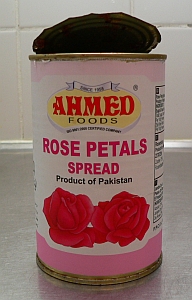
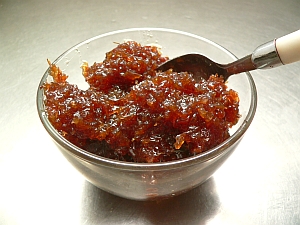
[3] Instead of elaichi, add rose water

[4] Mix in the red food color so that the mixture takes on a very light pink color
[5] Rose Kulfi is ready. Garnish with rose petals before serving.
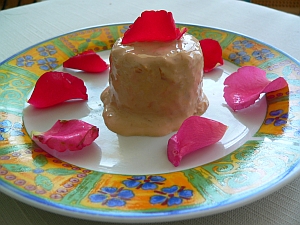
Shahi Badam Kulfi
Preparation time: 1 hour 10 minutes
Ingredients
1 litre evaporated milk (full cream)
500ml cream (30gm fat/100ml variety or equivalent)
175 gms sugar
100 gms badam
Seeds of 30 medium green cardamom pods
20 gm (2 tsp) corn flour
Preparation
Soak the badam in water for 2 hrs and then dry grind (coarse) them as shown below:

Method
[1] Take a thick bottom pan and put the evaporated milk (This milk is the regular milk which has been reduced to half) and the cream.
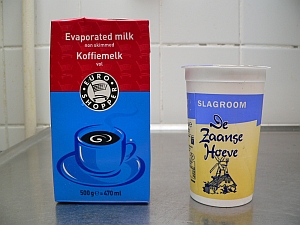
[2] Keep boiling on slow flame stirring most of the time till the milk-cream mixture is reduced to 4/5th. This should take between 30-40 minutes.
[3] Add the ground badam to the milk.
[4] Add all the sugar (Recommended that you adjust the sugar quantity as per your liking)
[5] Add the crushed elaichi seeds. (The image below is of seeds that need to be crushed)

[6] Now keep boiling for around 15 minutes
[7] Mix the corn flour in minimum water and add it to the milk. This would thicken the mixture.
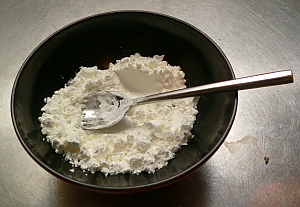
[8] Boil for 2-3 minutes and remove from flame

[9] Once cooled, transfer to disposable cups as shown below. Fill the cups to 1/3rd capacity

[10] Freeze for atleast 8 hrs.
Serving
30 minutes before serving, remove the Kulfi from the freezer and keep it in the fridge. This makes the Kulfi a bit soft. To remove the Kulfi , immerse the cup into a bowl containing warm water. This will loosen the Kulfi. Invert it on a plate and give it a light tap. Garnish with more badam.
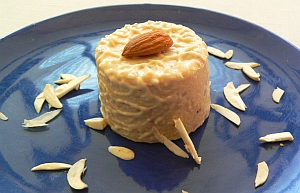
Variations
Kulfi can be made in similar fashion with the following Indian flavors:
- Rose
- Kesar
- Kewda
- Pista
Gotchas
The below are very important:
- Only thick bottomed or heavy guage vessels should be used for making Kulfi
- All prepartion on low flame only to avoid burning of milk
- Keep stirring most of the time
Friday, April 13, 2007
Biulir Daal (Urad Daal)
Ingredients
- Biuli (Urad) Daal ½ KG
- Ginger 5 cm
- Hing (Asafoetida) 1 tablespoon
- Salt to taste
- Oil
- Whole green chillies 3 - 5
Urad Daal
Boil the daal until it reaches a softness so that you can press it with your fingers and smash it. While boiling skim off the white crud that gathers on top of the daal also start with double enough water so that you have about two digits of water above the daal surface. At the end you do not want too much water or too dry a daal so if you feel add some water midway.
Ginger
Either grate or crush the ginger in a mixer
Hing
Mix the hing powder with little warm water
Cooking
- Heat oil
- Pour the hing in oil
- Pour the ginger paste in
- Stir for few minutes (make sure it does not burn, but you get the sweet ginger smell)
- Pour in the boiled daal
- Add the whole green chillies
- Add salt
- Stir and boil for another five minutes
Posto Chingri Bhape (Steamed Prawns with Poppy Seeds)
Ingredients
- Prawns ½ kg
- Poppy seeds ~200 - 400 gms
- Mustard seeds 30 - 50 gms
- Grated coconut ½ cup
- Mustered Oil 3 - 6 tablespoon (You may substitute mustard oil with any other vegetable oil but it will not be the same thing)
- Green chillies 3 - 5
- Salt to taste
Prawns
Clean the prawns. Clean the back. Leave the tail on if you like. This is generally not cooked with the head but if like keep them on. Wash them and let the excess water go away.
Poppy seeds
We need to make a paste of poppy seeds. This can be done various ways.
1. Old fashioned stone grinder
Soak the poppy seeds in water and then grind the standard way
2. Use the small container of a regular mixer
Fill the container as per specification, add some water and then use the high setting
3. Use a coffee grinder
Put dry seeds in the grinder then grind until the paste feels oily, then put the ground seeds in a bowl and mix water to make a paste
The paste should not be "too" smooth; when you squeeze it you should feel some seeds at your finger tips. Also make sure it is not very watery.
Remember to mix the mustard seeds with the last batch of the poppy seeds.Cooking
Mix all the ingredients with the prawns. Put the green chillies in to the mixture, if you like it hot break them.
There are various ways of cooking it
Traditional
Put the mixture in a metal container that can be closed properly and has a flat top. In a big vessel pour some water. Place the container with the mixture in the water. Let the water boil. Put something heavy (another pot with water will do) on top of the container so that it does not bounce around.
If you do not have a flat top container with lid then cover it nicely with aluminium foil. and put a plate that is little bigger on top and put something heavy on top.
Please make sure that water does not enter the container.
Ready in 45-50 minutes
Conventional Oven
Put the mixture in a oven safe container. cover in aluminium foil. Put in a preheated oven at 180 - 190 °C for 30 minutes.
Microwave Oven
Put the mixture in a microwave safe container cover with plastic wrap. Microwave at high for 20 minutes or at medium for 30-35 minutes.
Cooking time may vary. if the prawns are red and soft you are done.
Variations
The same dish is made with Rohu (Bengali Rui) and Hilsa (Bengali Ilish). The one with Hilsa is also a top favourite especially among the people from East Bengal (now Bangladesh).
However, for Hilsa the poppy seed is totally replaced by mustard seeds. Also some people do not use the coconut
Tuesday, April 3, 2007
Phulkopir Posto (Cauliflower with Poppy Seeds)
Posto - Poppy seed (khas khas) is not just used as a spice but is also used in considerable amount to create main dishes in Bengal. It is particularly popular in the districts of Burdwan, Bankura, and Birbhum. The most common preparation is with potato (Alu Posto). It is generally accompanied with Biuli or Kalai (both are Bengali names for Urad daal) daal. It is traditionally eaten with rice.
Ingredients
- Cauliflower (~ 1 kg)
- Poppy seeds (~200 - 400 gms)
- Onion seed/Black cumin (Kalonji, kala jira) 1/2 - 1 tablespoon
- Oil 3 - 6 tablespoon (To be hundred percent Bengali we need mustard oil. However, any other oil will do except may be ground nut oil)
- Salt to taste
Preparation
Cauliflower
Cut the cauliflower in small pieces (about 1 - 1.5 inches; it is best if you break the stem in order to keep the flower part intact instead of cutting through them and creating flat edges)
Poppy seeds
We need to make a paste of poppy seeds. This can be done various ways.
1. Old fashioned stone grinder
Soak the poppy seeds in water and then grind the standard way
2. Use the small container of a regular mixer
Fill the container as per specification, add some water and then use the high setting
3. Use a coffee grinder
Put dry seeds in the grinder then grind until the paste feels oily, then put the ground seeds in a bowl and mix water to make a paste
The paste should not be "too" smooth; when you squeeze it you should feel some seeds at your finger tips. Also make sure it is not very watery.
Cooking
- Pour the oil in the cooking pot.
- Heat the oil (if it is mustard oil then you have to heat it until the foamy bubbles go away
- Put the Kalonji in (you may want to cover at this point as the kalonji tends to jump around)
- Once the kalonji is fried put the cauliflowers in
- Sprinkle salt on the cauliflower
- Saute the cauliflowers until they are half cooked
- Pour in the poppy seed paste
- Mix thoroughly
- Saute for 10 minutes
- Pour water so that the cauliflowers are submerged
- Cook until cauliflower is soft to your liking and/or the water has evaporated (If you move the cauliflower to the side creating an empty space in the middle of the cooking pot then there should be no water in the middle)
Variations
This can be cooked various other vegetables notably with Zucchini and Eggplant. You may try your favourite vegetable, however, it does not workout well with sweet vegetables such as pumpkin, sweet potato etc., but you are free to try it yourself
Saturday, March 31, 2007
Chilly Idli
Ingredients: Plain Idlis, Capsicum, Onion, Tomato, Green Coriander, Chilli Sauce, Soya Sauce, Salt, Vegetable Oil
Method:
1. Cut Capsicum, onion, tomato lengthwise
2. Heat oil in a pan or kadhai and then add onions
3. Add Capsicum and then tomatoes along with chillies
4. Add idlies(whole)
5. Mix with sauces and vinegar
6. Stir the mixture for couple of minutes
7. Add salt and stir again to mix
8. Garnish with coriander leaves and hence serve the chinese south-indian dish
Important Note: Do not overcook onions, tomatoes and capsicum
Wednesday, February 21, 2007
Regional special
For the first time the meeting was held without the 'Food Club' coordinator Prakash & his wife Vandana as their kid was not well. The meeting strength was, otherwise, full.
Menu for this meet was:
- Handvo
- Amritsari Daal
- Shahi Gobi
- Kwark
Handvo as the starters were really tasty and already occupied bit of space in the human tumbler. Next to follow were the flowers or Gobis already fried and were waiting to be garnished with masala. This was prepared by myself. Once they were baked, every body enjoyed along with amristari dal and the parathas.
In the mean time, Ashwini's Kwark had gone fluffy. She garnished with fruits which made it look tempting. We had a small but enjoyable cake or Kwark cutting ceremony honoured by Dhwani. She was going to celebrate her birthday the next day. After we were full, there was normal len-den ki baat chaired by our treasurer Ashwini. Then we discussed about the next meeting which is going to be 'HOLI SPECIAL' and would be held in TCS office so that the neighbourhood is not being disturbed by holi shor gul.
The planning of this special meeting is in process and hope it gets finalized soon. We wish Aditya, Pooja and Palak a very enjoyable and safe trip to India. We hope to see them after two months.
Sunday, February 18, 2007
Asiatic Vegetable Bami
Ingredients:
Noodles 1 packet: Any brand
Onions
Finely Cut Vegetables: Capasicum, Cabbage, Spring Onion
[Tip: Different kind of ready made finely cut vegetables ae available in the market like Italian, Chinese or Indonesian Roerbak mix]
Butter or Refined Oil
Blackpepper: according to taste
Salt: according to taste
Noodles Masala: Variety of thenm available but the most preferred one is "Honig's Mix Voor Bami Speciaal - Aziatisch"
Sauces: according to personal taste
Method:
1. Cut onions length wise
2. Boil noodles
3. Heat oil/ butter in a pan or kadai.
4. Add onions after oil had become hot.
5. Add capsicum after two minutes
6. Add remaining vegetables afetr two minutes and stir them
7. Add noodles and stir
8. Add salt and black pepper
9. Add Sauces and stir
10. The noodles are ready after two minutes
Please note that the noddles should not be overcooked else they would get meshed up.
Wednesday, February 14, 2007
Cheese Onion Toast
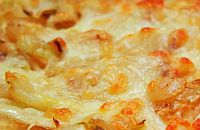 Cheese and onions are an excellent combination. Imagine a crispy toast topped with melted cheese on fried onions. Yummy, isn't it. This dish is a treat for cheese lovers. An excellent breakfast item or an evening snack.
Cheese and onions are an excellent combination. Imagine a crispy toast topped with melted cheese on fried onions. Yummy, isn't it. This dish is a treat for cheese lovers. An excellent breakfast item or an evening snack.Ingredients
2 slices soft white bread
1 medium onion
2 cheese slices or some grated cheese
Little oil for fying onions

Method
[1] Dice the onions and fry them till light brown
[2] Lightly toast the bread slices in a toaster
[3] Spread the onions on top of the slices

[4] Sprinkle some grated cheese on top of the onions

[5] Keep in pre-heated oven (225 degree centigrade) till cheese is melted and is slightly brown on the top (5~7 minutes)
[6] Enjoy with a cup of hot tea.
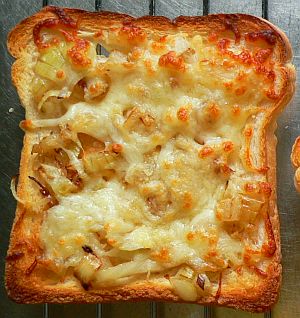
Variation
Use cheese slizces instead of grated cheese. You can also add some finely chopped green paprika along with the onions. The parika need not be fried like the onions
Gotchas
- Keep a close eye of the toast to avoid it burning.
- Handle the oven carefully.
Saturday, February 10, 2007
Veg Stir-fried rice
Ingredients
500 gms (total) of the following vegetables:
- Red Onions
- Bean sprouts (optional)
- Carrots
- Pointed Cabbage or Spitskool (Can use regular cabbage if spitskool is unavailable)
- Broccoli
- French beans
- Capsicum (Shimla mirch)
- Button mushrooms
500 gms Full boiled rice (Non glutinuous)
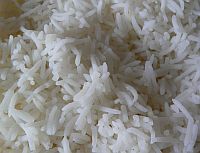
Ajinomoto (MSG - Mono Sodium Glutamate) to taste
Salt to taste
3 tbsp soya sauce
1tsp black pepper powder
2 tsp ginger garlic paste
1 tbsp Oil

Method
Note: All cooking on high flame only.
[1] Heat the oil in a wok and add ginger garlic paste.
[2] After 5 seconds add the onions and fry for 10 seconds
[3] Add carrots, beans, broccoli and fry for 20 seconds

[4] Add the remaining vegetables, add 1 1/2 tbsp soya sauce and fry for 20 seconds
[5] Now add the rice, sprinkle salt & MSG and then mix well with the veges.
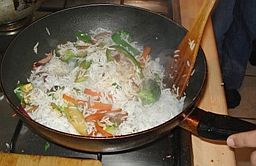
[6] Once mixed, add the remaining soya sauce, mix well for 30 seconds and serve hot.
[7] Enjoy Veg stir-fried rice.
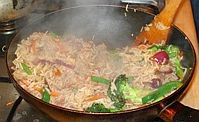
Variations
- Break an egg in the beginning and scramble it
- Put boiled chicken shreds as one of the additions to rice
- Increase or decrease vegetables as according to your liking
- Have the rice with a little tomato ketchup
Gotchas
- Not recommended to put vegetables not mentioned in this recipe like peas, cauliflower, etc. This makes the taste more Indian than Chinese.
- Pay attention to the amount of salt you add as Ajinomoto as well as soya sauce are themselves salty.
- Add vegetables in the order mentioned as the most dense veges go in first (and hence are cooked for a relatively longer period of time)
- All cooking is done on high flame.
- Ginger garlic paste sputters in hot oil. Take care.
- Do not overcook as then the crunch of the vegetables will go off.
Bread Upma
Ingredients
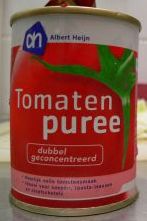
6-8 Slices of bread
1 tsp mustard seeds
1 tbsp tomato puree
1/2 medium firm tomato diced
2 tbsp Oil
1 medium onion diced
1/4 tsp turmeric powder
1 tsp paprika powder (or kashmiri mirch)
Red chilli powder to taste
Green chillies to taste
Salt to taste
Few Coriander leaves for garnishing
Preparation
All cooking for this recipe needs to be done on a high flame
[1] Slightly wet the bread slices under tap water and tear them apart as shown below.
[2] Dice Onions and Tomato.
[3] Heat oil in a wok and add mustard seeds. When the mustard seeds tend to crackle, add the diced onions and saute till onions turn brown.
[4] Now add the turmeric powder the tomato puree. Mix well.
[5] Add the wet torn bread slices, sprinkle chilli powder, salt and paprika powder and mix well.
[6] Cover this with the pan cover for 20 seconds. Remove cover. Mix well and again cover for 20 seconds.
[7] Uncover and add green chillies & diced tomatoes. Mix well and let it roast for 20 seconds.
[8] Remove from flame and garnish with coriander leaves.
[9] Enjoy bread upma.
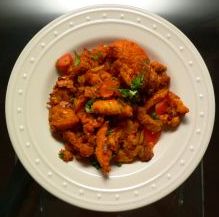
Variations
- Leave out the diced tomatoes
- Add jeera (carom) instead of mustard seeds
- Add curry leaves
- Minus the paprika powder if the dish is too red for you
- Use leftover bread sides (if you made some bread rolls or sandwiches) instead of the whole slice.
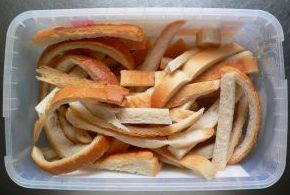
Gotchas
- Do not wet the bread too much, neither keep the bread completely dry
- Do not cover while cooking for periods more than what is mentioned in the recipe. This would make the bread soggy and sticky
- Do not cover once the diced tomatoes are added as this would cook them and make them mushy.
Friday, February 9, 2007
Curd Rice
This recipe of curd rice with grapes, oranges, pomegranate and onions makes it look colourful and enhance the taste.
Ingredients :
- Rice -2 cups cooked
- Plain -Yoghurt 4 cups
- Milk -1/2 cup
- Mustard seeds -1/2 tsp
- Seedless Grapes 1/2 cup
- Pomegranate- 1/2 cut
- Tinned Orange pieces -1/2 cup
- Red Onion-1 small chopped
- Few Curry leaves
- Chana dal/Urad dal-2tsps
- Oil or ghee-1 tbsp
- Asafoetida-1 pinch
- Salt to taste
- Coriander leaves for garnishing
- Green chillies -2
Preparation:
- Cool the cooked rice.
- Add yoghurt,milk into rice. Mix well. If it's not sufficient then you can put some more yoghurt depending on your liking. Add salt.
- Chop grapes and the orange into fine pieces .Remove the seeds from pomegranate. Chop the onion finely.Mix all of these to the curd rice mixture.
- Heat 1 tsp oil/ghee in a pan and put mustard seeds , green chilies (cut into small pieces),curry leaves ,asafoetida and the chana/urad dal.When the seeds pop, remove from heat and add them to the above curd-rice mix.
- Garnish with green coriander leaves.
- Put in the referigerator to chill for about an hour.
Gotchas:
If you leave the dish for 2-3 hours then the rice might soak all the yoghurt and it becomes dry. So you can put some more yogurt or milk.
Thursday, February 1, 2007
Murukku
A few weeks back we visited one of our other friends whose parents were visiting them. At tea we were again sered Murukku. I was delighted to know that they were made at home! I asked auntyji about the recipe and she assured me it was pretty simple. The last bit was to have the machine used to make murukku. She was more than happy to share that with us. So here I was all set to try this recipe. The machine is shown below.

Background
Murukku is a South Indian snack more commonly known in other parts of India as Chakli. I must admit that although the physical shape of Chakli and murukku is supposed to be the same, they are made of different materials. Chakli is made of gram and rice flour while Murukku is made of urad dal and rice flour.
Murukku is made in 2 varieties - Murukku & Kai Murukku. Kai Murukku is made by hand while and has a twisted chakli shape while murukku is made with a press machine as mentioned earlier. Both taste delicious. Murukku does not have a strict recipe and canbe varied based on what taste you prefer.
Ingredients
Non-glutinous Rice flour 1/2 kg
Dhuli Urad Dal 70-80 gms
Butter or Ghee 50-60 gms
Jeera or Ajwain seeds 1 1/2 tsp (Any one type Based on your preference)
Salt to taste
Red Chilli powder (Optional)
Very little water to knead the dough
Oil for frying
Method
[1] Soak Dal for 15-30 minutes. This reduces boiling time later.
[2] Put the Dal with very little water (Just enough to boil it) in a pressure cooker and boil it till done
[3] Grind Dal in a mixie or mixer
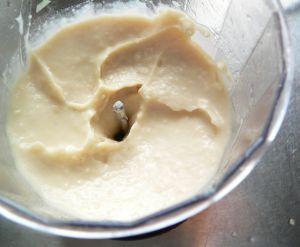
[4] Now put this Dal paste in a kneading tray and mix all the ingredients (Salt, Jeera/Ajwain,Chilli powder, Butter and Rice flour) slowly. Rice flour requires very little water to form a dough. However a few splashes or water may be required in the kneading process. The dough should neither be very soft nor very hard. The below picture should give a feel of how it should be. See the finger impressions. I did not press very hard to get this.
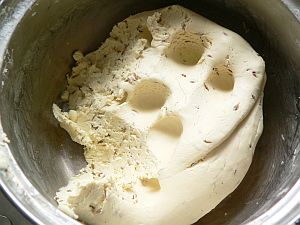
[5] Heat oil at high flame. All frying for murukku happens are high flame only!
[6] Fill the murukku machine with some dough and press it over the hot oil in the kadhai.
[7] Let murukku fry till it stops bubbling. Turn once.
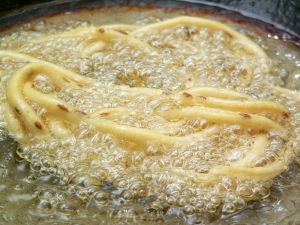
[8] Remove on a newspaper to absorb extra oil. After cooling store in an air tight container
[9] Enjoy murukku

Variations
As mentioned, you can put some of your favourite masalas in the dough for added taste but this is experimental. Murukku on its own tastes divine. Also if you are diet conscious, you can skip adding the butter or ghee. This will only make your murukku a bit hard.
Gotchas
- Most important things in this recipe that can easily go wrong are:
- Ratio of Urad Dal to Rice flour
- Dough consistency

- Murukku has to be extremely crisp. Always store murukku in an air tight container or else they may go soggy.
- If you are using salted butter, reduce the amount of salt you add to the dough.
- Lastly, be extremely careful while frying. The oil may sputter sometimes if dough consistency is not OK.
Monday, January 29, 2007
Meeting at Albert Heijn
Prince, Ashwini & Fakhruddin did not participate. Sarang is still in India.
We roamed around for amost 1.5 hrs but could not visit some sections for lack of time. In particular no discussion happened for - Breads, Frozen stuff, eggs & ice cream. The rest of AH was pretty much covered with good information sharing. Dhwani and Chirag are now OK with the cheese and I have learnt about some interesting salads. Others have learnt about the various potato and cheese types. Members now know what 48+ on a cheese packet means. Ritu/Dhwani have been introduced to the Italian tapenede & pesto as nice spreads when making a sandwich.
In all the discussion, following was the verdict of the members:
- Cool Best - Mango Dream is a very nice juice
- Courgette or Zucchini can be prepared just like lauki
- Caesar and Greek salads are very nice
- Johma Komkomer bread spread/salad is not very nice.
- Dutch aardappel salad is worth a try
- Coleslaw on its own is not very good
- These chips should not be missed out - Super chips HOT, Super Chips - Heinz Tomato Ketchup, Super Chips -Spare ribs, AH Corn Tortillas, Doritos - Geen Style
- Non alcolic beverages (Fizzy) - Fernandes - Green Punch & Pineapple
- Non alcolic beverages (Non-Fizzy) - Limondaine - Orange & Lemon
- Light alcoholic - Shandy (0..5% alc. v/v)
- Using Roomboter, Ghee can be prepared at home
- Duyvis - Drp Roasted & Baked pindas or peanuts taste divine
- Bolletje Pinda & Kaas Pepsels are an interesting party snack
- Heinz sandwich spreads are a great variation for sandwich lovers. The Komkomer variety is not very nice. Rest all flavors are pretty OK.
Friday, January 26, 2007
Oriental Noodle Soup
Ingredients
1.Oil 11/2 tbsp
2.Garlic 3 flakes chopped
3.Mushrooms 6 sliced and then finely chopped.
4.Carrot 1 grated.
5.Green capsicum 1/2 fine chopped
6.Spinach leaves fine chopped
7.Tomato puree 3 tbsps.
8.Whole red dried chillies -deseeded and broken into small pieces.
9.Noodles -30 gms boiled.
10.Salt and pepper to taste
11. Rind of one lemon
12. Chilly Sauce 2 tsps.
13.Vinegar 11/2 tbsps
Preparation
1)Prepare the lemon rind by grating a firm whole lemon without applying too much pressure.Grate only the yellow/green skin and not the white bitter pith beneath the yellow/green skin.Keep this aside.
2) Boil the noodles and keep aside.
3)In a pan heat the oil and saute the chopped garlic for 1/2 minute.
4)Add the chopped mushrooms,capsicum and the grated carrot and stir fry for 1 minute.
5)Add the tomato puree and red chilles and stir for 1/2.
6)Add 4 cups of water and bring the soup to boil. Add the noodles and further cook for about a minute.
7)Add salt,pepper, lemon rind, chilli sauce and vinegar.
8)Add the finally shredded spinach and simmer for a minute.Serve hot.
Variations
You can use cabbage, broccoli alongwith the other vegetables.
You can also use chicken to make this soup. But chicken has to be shreddded and cooked before adding to the soup alongwith the other vegetables.
Gotchas
The soup should be had immediately else the noodles will become very soft.
Tuesday, January 23, 2007
Pineapple Souffle
Ingredients
1.Condensed milk 1 tin
2.Tinned pineapple-2 tins
3.China Grass(Agar Agar)-20gms
4.Lemon juice -6 tsps
5.Cream 450 ml
6. Pinapple essence -3 tsp
7. Few drops of yellow colour
8. Few cherries for decoration
9. Sugar -1/2 cup
Preparation
1)Beat the condensed milk till light.
2)Chop all the pinapple pieces.
3)Take 2 cups of pinapple syrup from the tin and and add 1 cup water to it(Add some sugar to the syrup if it is very sour). Boil this mixture on low heat and keep this covered .
4)Put china grass in a pan and add 21/2 cups of water to it and keep aside for 5 minutes.Heat it on low flame stirring well till it dissloves.
5)Add the hot china grass solution to the hot pineapple syrup and stir well.
6)Now add the condensed milk ,pineapple pieces and lemon juice to the above mixture , mix well and keep aside till it cools down to room temperature.
7)Beat 400 gms cream well alongwith the sugar till it becomes slightly thick.Add this cream to the condensed milk mixture.
8)Add essence and colour and mix well.
9)Pour in a serving dish and refrigerate for six hours.
10)Whip the remaining 50 gms of cream till soft peaks are formed.Use this to decorate the souffle alongwith cherries.
Variations
Instead of using the china grass you can use gelatine in the same proportion.
Gotchas
The China Grass mixture should always be added to a warm dessert mixture else it will set as tiny rubber like pieces and will not blend well with the dessert mixture and hence the dessert will not set properly
Sunday, January 21, 2007
Chinese special
- Oriental Noodle soup (Pooja)
- Stir fried vegetable rice (Prakash)
- Bami (Indonesian Noodles) (Ritu)
- Pineapple soufle (Pooja)
During this first hour I had all the members taste a South Indian snack - Murukku - that I had prepared a couple of days back. All appreciated it and some asked when it would be taught. The recipe of murukku will be posted soon.
Pooja started with showing us how to make soup. There was one interesting ingredient that caught the attention of many - Lime rind. On checking this, the bowl containing this was dropped and Aditya had to get some more Lime rind. Meanwhile I also managed to topple over a plate full of veges! Oh! my ... what a start. We anyhow managed to get started and the soup was ready in no time.
We all enjoyed it and the stage was then set for me to showcase my recipe - Stir Fried vegetable rice. Since all veges were already cut, I quickly got started after donning my Chef avtar. It started with Ginger Garlic sputtering in the hot oil and ended soon as the finished dish. The dish was appreciated. Since there was enough raw ingredients for the recipe, Ashwini & Prince gave it a try with 2 more rounds of Stir Fried vegetable rice.
After some club discussion we started off with Ritu getting ready for the Bami. Fakhruddin left after having an early round of the dessert. He had an engagement elsewhere. Bami is a noodle dish that comes from Indonesia. Ritu started with frying the veg mix in butter, followed by the bami spices and noodles. It was a quick dish. We all had it and remembered the good old Maggi Masala noodles. The dish tasted somewhat like it.
Till now we were all quite full and it was almost 4 hrs since the meeting started. We decided to enjoy the dessert that was prepared for it takes quite some time to make. The soufle was finished in no time. Everybody liked it very much. Pooja explained the recipe and some folks vouched to try it themselves.
With that it was time to leave. Another successful meeting with a perfect end.
Wednesday, January 17, 2007
TIP: Hottest thing on Earth
The Surinamese population in Holland are the only consumers of this pepper. Adjoema looks like bell pepper and may easily be taken for a small Shimla mirch. It comes in Yellow, Red, Orange and Light Green colors, however I do not know how they are different. The below picture shows red and yellow ajumas.
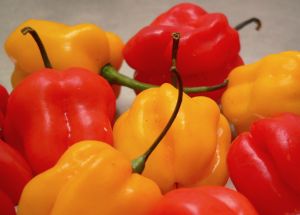
As green chillies have a very nice flavor, Ajumas too have a flavor. Of what I have experience, the flavor is not very nice and may not appeal to Indians. A couple of Ajumas may overpower a curry with their flavor in addition to making the curry exceptionally hot.
Ajumas can be purchased from Turkish/Surinamese stores and in some cases also super markets. They cosy anything between € 10-15 per kilo depending on the quality and freshness. Green chillies on the other hand range from € 6-9 per kilo.
Do give it a try.
Update: I found out lately that these peppers are also known as Madame Jeanette!
Update2: (Taken from wikipedia)
The substances that gives chili peppers their intensity when ingested or applied topically is
capsaicin (8-methyl-N-vanillyl-6-nonenamide) and several related chemicals, collectively called
capsaicinoids. Capsaicin is the primary ingredient in pepper spray. The "heat" of chili peppers is
measured in Scoville units (SHU). Bell peppers rank at 0 (SHU), New Mexico green chilis at about 1,500 SHU, jalapeños at 3,000–6,000 SHU, and habaneros at 300,000 SHU. The record for the hottest chili pepper was assigned by the Guinness Book of Records to the Naga Jolokia, measuring over 1,000,000 SHU.
Monday, January 15, 2007
I wish knew how to cook this
Member, Will teach, Wants to learn
Ashwini, Bread Upma (Style 2), Continental dishes
Aditya, Quick pasta salad, Honey sesame chinese chicken
Pooja, Oriental Noodle soup, All sorts of desserts
Ritu, Moong Dal Vada, Tandoori Vegetarian dishes
Prakash, Stir fried vegetable rice, Fried Chicken (KFC style)
Vandana, Samosas, Thai curry (preferably green)
Prince, Chettinadu chicken, ??
The Kachori surprise
Sarang was supposed to teach Paneer Tikka Masala in this session but unfortunately because he was not feeling well, he was excused. Aditya took up this last minute change by substituting Sarang's dish with Karnataka curd rice. So, the finalized menu for the day was:
- Bread Upma as the starter
- Karnataka Curd Rice & Dal Kachori as the main dishes
- Fresh-N-Fruit cream as the dessert
Now before I describe what happened, let me tell you something about the dish Dal-Kachori. This Kachori thing was a bit of a surprise because it was very different from the kachori or kachaudi that we have in the Northern part of India. The dish was very different with a unique combination of minty aloo bonda with spicy dal mixed with onions and a couple of chutneys. This was prepared by the host Dhwani who had actually pre-prepared it!!! The purpose of home meetings is to actually see the person demonstrate the recipe in front of us, so that was a bummer. Anyhow, not everybody is informed.
Since the Dal Kachori was pre-prepared, we started off with Aditya showing us how to make Karnataka curd rice. Curd rice is consumed pretty regularly (sometimes on a daily basis) in the south part of India. However, all the 4 southern states have their own versions of curd rice. The one Aditya taught us was a more spiced up version of the curd rice that comes from the state of Karnataka. Aditya got all stuff cut nicely arranged and cut from house that saved time. Once made, the curd rice was cooled for later consumption.
The kitchen was now free for me to demonstrate the starter - bread upma. The dish was demonstrated in completeness from start till comsumption :) It was well appreciated with Aditya telling that they were aware of a similar version and Ashwini informing of a completely different way of making a dish that involved defacing bread slices in a similar way. We would schedule this second way of making bread upma in a later session.
Ritu had come all prepared with a variety of fruits for her fruit cream recipe. It took considerable time to cut all the fruits. In the mean time cream and sugar were being introduced to each other who seemed to enjoy each others company. Once the fruits were all cut, Ritu completed the demonstration but informing about the other ingredients and in what proportions they went into making the dessert. The fruit cream then joined the curd rice in the fridge as it is best consumed cold.
With all the demos over, it was time to enjoy the main dishes. We started off with dal-kachori to be followed by curd rice. It was ample delicious food to be topped up with the cold fruit cream. Everybody was pretty full and thoroughly enjoyed the gathering.
Just before leaving we finalized on the next meeting date and discussed the club rules. The club rules have been simplified and finalized to everybody's delight. Accounts were settled and the suggestion to pre-populate the club kitty for a month was given. We would be implementing this in our next club meet. I also shared the Ajuma tip along with Ajumas :) with everybody. Everybody was given 2 Ajumas (A red and a yellow one) to take home and give it a try.
So that was it. Another meeting successfully completed with members to take home 4 new recipes.
Friday, January 12, 2007
Fresh-N-Fruit Cream
Ingredients :
Albert Heijn's Creme Fraiche (Cream Fresh) [ or equivalent thick fresh cream] - 1 pack [3-4 people]
Sugar - as required
Dry fruits - mixture of almonds and pistachio cut in small pieces
Tropical fruits like grapes,orange,apple,pineapple,banana [fresh or tin packed] cut in small pieces
Cherries - for decoration
Essence - Vanilla or pineapple (1 tbsp)
Method
Mix sugar in cream and beat it till sugar gets properly dissolve in it and then mix all the cut fruits along with essence. Hence, garnish the cream with dry fruits and finally decorate it with cherries. So simple, isn't it !!!
Wednesday, January 10, 2007
Fried Fish
I don't think so this would be available in restaurants but can be readily had in any Open Market. There are several around. Of what I know we have open markets in Amsterdam and sub-urbs at the following places:
- Albert Cuypstraat (Everyday)
- Bijlmer (Mondays & Thursdays)
- Amstelveen Binnenhof (Fridays)
One can buy this nugget sized fried fish (We are really missing a photo here, aren't we) for any amount. I generally prefer for €2 which is sufficient as a quick snack. You can additionally buy some sauce with this but I do not recommend it. Some shops have a kind of masala (which is paprika and salt mixture I believe) that you can sprinkle on the fish for a stronger taste.
This fried fish has no smell, so if you do not eat fish because the smell, give this a try. If you a fish lover, you are really missing something.
Chicken Biryani
Ingridients:
1 Kg good Basmati rice.
1 kg Chicken (can add more)
8-10 Onions
1Table spoon ginger-garlic paste.
1tsp turmeric
kashmari mirch powder for colour
salt
Ghee
Cooking oil
mint leaves ,corriender leaves.
yogurt
potetoewadges,
kaju 10-12 in halves
for biryani masala
tamal patra 3-4
blackcardimom 2
green cardimom 6-8
cloves 8-10
black pepper 20-25
dalchini 2 inch
procedure:
1.Clean and cut chicken add ginger garlic paste,turmeric powder ,mint pasteand yogurt (can add some green chilli paste to make it more spicey). keep in refridgerator for atleast 6 hrs.
2.wash rice and boil with equval quantity of water. as soon as the steam goes seperate the rice in a big thali and let it cool
3.cut 2 onions in long strings and keep seperate.remaning onins chop finely.
4(a)heat the oil in pan and fry onions stings only till dark brown remove from flame and set aside.now in same oilfry potetoes,kaju and finallybiryani masala each item seperatelly and grid till fine powder set aside.
4(b) ligtekly roast saffron and mix in half cup milk.
5.now in the same pan add some more oil and fry choped onions till soft now roast with chilli powder and add tomatoe puree. now as the oil starts leaving greavy add chicken and cook till half done. the yogurt will leave water and chicken willhave some gravy we need this .
6.now we have to start puting layers.
in a thick bottom vessel set some rice add chicken with gravy now add one more layer of rice over it add biryani masala, soffron milk ,ghee,kaju, corrinder,potatoes and keep making layers .Now finally keep the vessel on very low flame till the rice is done and u get really good aroma.Remember to keep the lid tightly closed and do not open frequently.
To increase the aroma of biryani heat a peace of charcoal ,when red hot put in a katori place the katori on top of rice and pour a spoon of ghee and close the lid immediatly and keep some heavy thing on the top so the steam will not leavethe vessel.
Searve the biryani with onoin tomato raita.
Friday, January 5, 2007
First home meeting
It was a dinner meet and menu for the evening was:
- Chana Kababs
- Chicken Biryani
- Fried Rice
- Orange Cream
